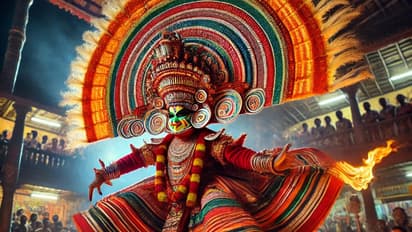Thirayattam – The divine dance drama celebrating Kerala's folklore

Synopsis
Thirayattam is a vibrant ritualistic performance native to North Kerala, particularly in the Malabar region. This sacred folk art form, deeply rooted in the cultural heritage of the state, blends elements of dance, music, and theater. Performed in sacred groves and village shrines, Thirayattam is an offering to deities, showcasing elaborate costumes, intense rhythmic movements, and mystical storytelling.
Thirayattam is one of Kerala’s most vibrant and spiritually significant ritualistic performance arts. Rooted in centuries-old traditions, it is performed as an offering to deities in sacred groves (Kavu) and temple premises, particularly in North Kerala’s Malabar region. Combining elements of dance, music, theater, and martial arts, Thirayattam is both a devotional practice and a community spectacle that reflects Kerala’s rich cultural and spiritual heritage.
Origins and Significance
Thirayattam, derived from the Malayalam words Thira (sacred space) and Aattam (performance), is believed to have originated from ancient folk and Dravidian traditions. It is closely associated with the worship of Bhagavathi (Goddess Kali), heroes, and ancestral spirits. The performance is deeply ritualistic, often considered a form of divine invocation where the performer embodies the deity they represent.
Where is Thirayattam Performed?
Thirayattam is primarily performed in the sacred groves (Kaavus) of Kerala, particularly in districts like Malappuram, Palakkad, and Kozhikode. These groves are considered divine spaces, dedicated to local deities and ancestral spirits, and serve as the stage for this spiritual performance.
Also Read: Sarpakavu: Kerala’s Ancient Snake Groves and its Spiritual Importance
Costumes and Makeup
The performers of Thirayattam wear elaborate costumes and vibrant makeup, which are crucial in bringing the divine presence to life. Key elements of the attire include:
Headgear (Mudi): Intricately crafted and often decorated with flowers and ornaments.
Face Makeup: Done in striking colors, with red and black dominating to symbolize power and aggression.
Costume: Heavy, layered clothing often made from natural fibers and decorated with mirrors and metallic embellishments.
Ornaments: Traditional jewelry, bells, and anklets enhance the grandeur of the performance.
Performance Rituals
A Thirayattam performance follows a structured ritual that includes:
Purification Rites: The performer undergoes a spiritual cleansing process before donning the costume.
Invocation of Deities: Chanting of hymns and playing of traditional instruments like Chenda (drum) and Ilathalam (cymbals) invoke divine presence.
Trance and Possession: The performer enters a trance-like state, believed to be possessed by the deity they are portraying.
Dance and Drama: The performance consists of dynamic movements, aggressive expressions, and symbolic gestures narrating mythological stories.
Blessing the Devotees: At the end of the ritual, the performer blesses the devotees, marking the completion of the sacred event.
Musical Elements
The music accompanying Thirayattam is a key aspect of its intensity and spiritual power. Traditional percussion instruments like Chenda, Maddalam, and Kurumkuzhal are played rhythmically to match the energy of the performance. The beats create an immersive experience, often leaving the audience in awe.
Variants of Thirayattam
Different regions in Kerala have their own interpretations of Thirayattam, with variations in costume, music, and themes. Some well-known forms include:
Bhagavathi Thirayattam: Dedicated to the Goddess Bhagavathi.
Gulikan Thirayattam: A powerful performance representing Gulikan, a form of Lord Shiva associated with time and death.
Karinthirayattam: A darker, intense form symbolizing destruction and protection.
Thirayattam in Modern Times
Though traditionally confined to temples and sacred groves, efforts are being made to preserve and promote Thirayattam. Cultural festivals and tourism initiatives have brought it into the mainstream, ensuring its survival for future generations. Despite modernization, the essence of Thirayattam remains deeply spiritual and continues to be a revered ritual in Kerala’s cultural landscape.
Thirayattam is more than just a performance—it is a spiritual journey that connects devotees with the divine. Its intricate blend of mythology, dance, music, and ritual makes it one of Kerala’s most mesmerizing and significant cultural traditions. As a symbol of devotion and artistic excellence, Thirayattam continues to thrive, keeping Kerala’s ancient spiritual heritage alive.
Thulabharam Ritual: Weighing Devotion at Kerala's Guruvayur Temple